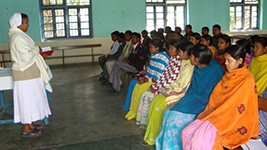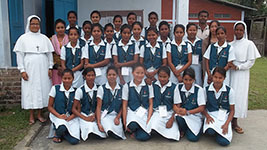Our Founder
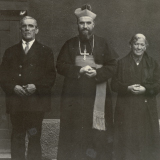 Stephen Ferrando was born as the second of the three children to Mrs. Josephine Salvi and Mr. Augustine Ferrando on 28th September 1895 at Rossiglione in the Province of Genova, Italy. He had an elder sister named Maria who was two years older than him and a younger brother John Baptist who was three years younger to him. Born and brought up in a pious and hardworking middle class family Stephen Ferrando acquired those traits in his life. He said “From my family I received a rich heritage; a great love for God and Madonna, spirit of sacrifice and a temperament inclined for joy”.
Stephen Ferrando was born as the second of the three children to Mrs. Josephine Salvi and Mr. Augustine Ferrando on 28th September 1895 at Rossiglione in the Province of Genova, Italy. He had an elder sister named Maria who was two years older than him and a younger brother John Baptist who was three years younger to him. Born and brought up in a pious and hardworking middle class family Stephen Ferrando acquired those traits in his life. He said “From my family I received a rich heritage; a great love for God and Madonna, spirit of sacrifice and a temperament inclined for joy”.
Being very simple and serene, though smart Stephen was a victim of the pranks of his companions who loved to make fun of him in his childhood days. He was able to laugh at his own follies and never took offence when he was laughed at. Often he sought to be alone and reflective. He appeared to be an ordinary boy that no one speculated on what he would become in the future.
School Life
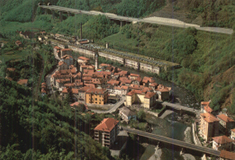 He did his early schooling in his own village, Rossiglione. On 9 October 1904 he was admitted to Salesian boarding school at Fossano. He was enrolled to Don Bosco’s own Oratory, at Valdocco, Turin for the Middle School Education. He was admitted to the Salesian School at Valdocco on 24 October 1907 and remained there till 24 July 1909. He was a person of great discipline and etiquette. His teachers loved him for his calm and simple nature and for his obedience and cheerful disposition. He was much sought after by his companions for fun and humour.
He did his early schooling in his own village, Rossiglione. On 9 October 1904 he was admitted to Salesian boarding school at Fossano. He was enrolled to Don Bosco’s own Oratory, at Valdocco, Turin for the Middle School Education. He was admitted to the Salesian School at Valdocco on 24 October 1907 and remained there till 24 July 1909. He was a person of great discipline and etiquette. His teachers loved him for his calm and simple nature and for his obedience and cheerful disposition. He was much sought after by his companions for fun and humour.
While at Valdocco he had the opportunity of knowing personally some of the outstanding Salesians like, Fr. Paul Albera, Fr. Philip Rinaldi. Here he entered cheerfully and generously into the round of the various activities that bound him and his companions together. His close contact with the Salesians at Valdocco most of whom personally knew Don Bosco, possessed the warmth and love infused by Don Bosco and enthused by the challenging motto of Don Bosco “Give me souls and take away the rest” he expressed to his superiors his desire to become a Salesian priest. Later when he went home he expressed his desire to his parents too who were very happy to support their beloved son to pursue his desire and encouraged him in his studies. Though they had to put up with financial constrains and make lot of sacrifices, they sent Stephen to Valsalice, Turin for his high school studies.
The inspiring episodes and narrations of the missionaries challenged the young minds of the boys in the boarding houses and Schools and also the formation houses of the Salesians. The missionary life of the Salesians awakened Stephen’s imaginative powers and he desired intensely to be like them.
Thus on completion of his high school studies, Stephen Ferrando was admitted to the novitiate at Foglizzo on 14 September, 1911 and received the clerical habit on 19 October 1911 from Don Giulio Barberis the novice master. There “He distinguished himself among the confreres for maturity in judgment, for strong spirit of piety, for balance and equanimity of character, for prudence and exactitude in obedience, humble and docile submission and spirit of sacrifice.” Stephen Ferrando made his first profession on 15 September 1912, at the age of eighteen.
A Missionary
While doing his practical training at Borgo San Martino as a cleric, an unexpected letter reached Stephen Ferrando from his Major Superiors in Turin for they wanted to know what type of apostolate he would like to do as a priest. He promptly filled in the form writing a single word in capital letters “MISSIONARY”. He made his choice forever and gave his word. He simply wanted to be a missionary in any part of the world. He wanted to dedicate his whole life for the cause of Christ in the missions.
World War I
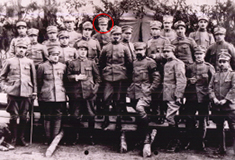 In the words of Stephen Ferrando, “Second unexpected letter came a year later when Italy joined the World War I. The summons to take up arms in the battlefield in defense of my country came like a bolt from the blue for me and my companions”. For four years (1915 – 1918) he was kept in the frontlines of the battlefield. Entrusting himself and his future plans into the hands of God he approached the frontiers of war with an attitude of pride and loyalty towards his motherland – Italy. He kept this flame alive and prayed fervently everyday and looked forward eagerly to the end of the war.
In the words of Stephen Ferrando, “Second unexpected letter came a year later when Italy joined the World War I. The summons to take up arms in the battlefield in defense of my country came like a bolt from the blue for me and my companions”. For four years (1915 – 1918) he was kept in the frontlines of the battlefield. Entrusting himself and his future plans into the hands of God he approached the frontiers of war with an attitude of pride and loyalty towards his motherland – Italy. He kept this flame alive and prayed fervently everyday and looked forward eagerly to the end of the war.
In the battlefield, his superiors recognized his practical intelligence and ingenious spirit of bravery. He was honoured with awards and medals; with recognitions and promotions; from Sergeant to Lieutenant, from Cammandatore to Cavalier and to Grand Official of the Italian Republic.
He received the following recognitions for the great services he rendered in defence of his homeland:
A Medal of Honour from the Lt. General of the King of Italy- 28-3-1917
Decorated with a silver Medal – 1919
Conferred title of Commandatore by Victor Emmanuel III- 14-2-1935
Made Cavalier & given title of Grande Ufficiale Republica Italiana – 03-03-1971
Same honour was conferred by the Prefect of Genova – 13 -10-1974
Diploma Accademico Onorario by the president, archeological Academy of Italy- 04-11-1974
With deep faith in God and sincere effort to do “Always better; always more”, Stephen Ferrando achieved all these, though many times he had to risk his life and just trust that God will take care of him.
Soldier Of Christ
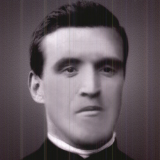 The war ignited further Stephen’s desire to be a missionary priest. Though it opened before him new avenues and vistas for a promising future, with all the laurels and titles attached to his name, yet the goal of life before Stephen was very clear. When in 1918 aged twenty five years, the war was over he returned to his seminary to continue his priestly formation, a mature and renowned ex-military man. The superiors gave him a year to discern his vocation, while he taught at the Institute Tecnico – Commerciale Liceo-Ginnassio in Constantinopoli, from 15 March to 15 December 1919.
The war ignited further Stephen’s desire to be a missionary priest. Though it opened before him new avenues and vistas for a promising future, with all the laurels and titles attached to his name, yet the goal of life before Stephen was very clear. When in 1918 aged twenty five years, the war was over he returned to his seminary to continue his priestly formation, a mature and renowned ex-military man. The superiors gave him a year to discern his vocation, while he taught at the Institute Tecnico – Commerciale Liceo-Ginnassio in Constantinopoli, from 15 March to 15 December 1919.
Stephen knew what he wanted and so he came to the Salesian major seminary to do his theological studies in 1920. He made his perpetual profession on 26 December 1920. On 18 March 1923 Stephen Ferrando was ordained a priest by Cardinal Albino Pella, Cardinal of Alessandria. It was a day of great joy to his parents and family members.
He receives a third letter of surprise now from his Rector Major, Fr. Philip Rinaldi. It read “…You are to go to the Indian Missions – Assam. Lead the group of young novices to the mission of Assam. Be ready to report immediately...” Ferrando was overjoyed, yet suddenly felt unprepared for such a call. Tested and tried in the furnace of World War I as an ‘iron soldier”, after the initial shock he was prepared to give himself wholeheartedly to face the difficulties of the mission field.
Thus on 2 December 1923 Fr. Stephen Ferrando, along with Cleric Joseph Foglia and eight novices left for Venice to travel to the Assam Missions. They arrived in Bombay on 18 December 1923. But they had to continue travelling for few more days to reach their destination. At last on 22 December 1923, they reached Shillong, the land of their dreams. They were surprised to see practically the whole Catholic community waiting to welcome them there. Fr. Ferrando expressed his sentiments of their journey.
“At that time I was a new priest, twenty eight years old, after having served for four years in the army, during World War I as an Official of Health and decorated with a silver Medal; I was happy to have given up that office, to be the Soldier of Christ, as the leader of a missionary group. Now I was leading a spiritual army”.
Novice Master
The first Salesian novitiate in India started on 20 January 1924 at Shillong. Fr. John De Ponti was appointed as the first Novice Master, Fr. Stephen Ferrando as the Socius and Bro. Joseph Foglia as the Assistant. Due to ill health, Fr. De Ponti had to leave for treatment to Calcutta and then to Italy only after 10 months of his stay as novice master. Thus Fr. Stephen was appointed the new novice master. As he accepted the new responsibility with a smile he said, “I have not yet learnt anything and yet I have to teach others already. The Lord continues to surprise me…” He served as the catechist of Our Lady’s House, the master of novices and the Rector of Our Lady’s House, and from 1929 as a council member of the Provincial Council of the Salesian Congregation in Northeast India.
Contextualised Formation
Fr. Ferrando was full of spirit and zeal for missionary work and the novices emulated the same. His creativity found new ways and means to acquaint the novices with the challenges of the missions. He often took them to the villages, walking miles together. Such visits helped them to learn the customs of the people and how to adapt themselves to various circumstances. Such visits were also used for learning language in a very practical way. He also had an extraordinary way in which he could keep the Family spirit of the community alive. He thus served in the capacity of Novice Master for 10 years. While being the novice master Fr. Ferrando found enough time and opportunity to be with the people in the villages, and regularly wrote about the Assam Missions to the superiors in Rome. He felt the greatness of God fully manifested in the multi- cultural and multi- lingual system in the Assam Missions. For him it was “a real Pentecost”.
Bishop of Krishnagar
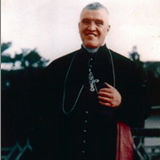 On 9 July 1934 Fr. Ferrando was appointed as the Bishop of Krishnagar,in West Bengal. The consecration took place on 10 November 1934. He was consecrated Bishop along with Mgr. Louis Mathias who was appointed Bishop of the new diocese - Shillong amidst a very solemn celebrations. Then on 21 November 1934 Mgr. Stephen Ferrando left for Krishnagar and reached there on 24 November accompanied by the Archbishop of Calcutta and the Bishops of Dinajpur and Shillong. A representation of the priests, catechists and the people welcomed them at the station of Ranaghat. His first solemn Mass was celebrated on Sunday 25 November.
On 9 July 1934 Fr. Ferrando was appointed as the Bishop of Krishnagar,in West Bengal. The consecration took place on 10 November 1934. He was consecrated Bishop along with Mgr. Louis Mathias who was appointed Bishop of the new diocese - Shillong amidst a very solemn celebrations. Then on 21 November 1934 Mgr. Stephen Ferrando left for Krishnagar and reached there on 24 November accompanied by the Archbishop of Calcutta and the Bishops of Dinajpur and Shillong. A representation of the priests, catechists and the people welcomed them at the station of Ranaghat. His first solemn Mass was celebrated on Sunday 25 November.
Within three months of his arrival in Krishnagar Mgr. Ferrando toured the whole of his diocese and had formulated a clear plan of action. He was not spared of trials and sorrows during his short-term as the Bishop of Krishnagar. Acute scarcity of food due to flood on one side and draught on the other side; the unexpected death of Cleric Aloysius Cesarin were things beyond his control and least wanted. Though his stay was very short yet, he made it very impressive and laid a strong foundation for the Catholic Church as well as Salesian Congregation. The will of God destined him a happy return to the land which he had made his second home already. Thus on 26 November 1935, Pope Pius XI transferred Bishop Stephen Ferrando from the See of Krishnagar to that of Shillong.
Return to Shillong
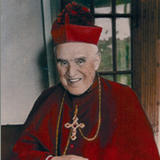 A long and tedious journey brought back Bishop Ferrando from Krishnagar to Guwahati as the new Bishop of the region on 23 January 1936. He had left Krishnagar on 14 January 1936 and went to Calcutta to prepare for his return to Assam. That evening of his arrival at Guwahati was a cultural programme with items by Garos, Boros, Uraons, Mundas and Santhals. His solemn entry into Shillong as its new Bishop took place on 14 March 1936. On his arrival he knelt down and kissed the earth of his new diocese as an expression of his sincere love, joy and dedication for the cause of Christ. Knowing his entry into the new diocese is going to be a long “way of the Cross” he renewed his priestly motto: ‘On the Cross is Salvation’, and offered it at the feet of Jesus Crucified and prayed to accept this offering of the immolation of his life for the salvation of Souls entrusted to his care. With such a spirit of total self-dedication, to the point of sacrificing his life, did Bishop Ferrando take charge of the Diocese of Shillong.
A long and tedious journey brought back Bishop Ferrando from Krishnagar to Guwahati as the new Bishop of the region on 23 January 1936. He had left Krishnagar on 14 January 1936 and went to Calcutta to prepare for his return to Assam. That evening of his arrival at Guwahati was a cultural programme with items by Garos, Boros, Uraons, Mundas and Santhals. His solemn entry into Shillong as its new Bishop took place on 14 March 1936. On his arrival he knelt down and kissed the earth of his new diocese as an expression of his sincere love, joy and dedication for the cause of Christ. Knowing his entry into the new diocese is going to be a long “way of the Cross” he renewed his priestly motto: ‘On the Cross is Salvation’, and offered it at the feet of Jesus Crucified and prayed to accept this offering of the immolation of his life for the salvation of Souls entrusted to his care. With such a spirit of total self-dedication, to the point of sacrificing his life, did Bishop Ferrando take charge of the Diocese of Shillong.
True to his motto, right from the beginning Archbishop Ferrando became the Apostle of Christ following in the footsteps of St. Paul.
When Bishop Ferrando took up the leadership of the vast diocese of Shillong, he had a vision for the whole region: “To lead the whole of North East India to Christ”. To achieve this goal he made use of all the means that could be harnessed. Two major problems harassed him in the new diocese: shortage of personnel and lack of funds. To add to these there were a number of trying situations which made the whole region and all the missionaries go through pressing times. The greatness of Bishop Ferrando lies in the fact that in the midst of difficult situations he was able to keep up the missionary enthusiasm of all who were with him, and managed to maintain the focus on the mission throughout his episcopate. He echoed the missionary call of St. Paul who said, “Woe to me if I do not preach the Good News.” Following his Master, Archbishop Ferrando was always on the move through his diocese to teach, to strengthen in the faith, to encourage and to lead to Christ thirsting souls. He put enthusiasm in the hearts of his priests, religious, catechists and every Christian for the cause of evangelization. As the Father of the Diocese, right from the start, he excelled in winning the hearts of all and gained their love, and reverence and obedience.
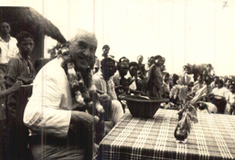 His missionary method was completely people oriented. He travelled for miles on foot across forests and paddy fields to reach the Christian communities, at times wading through rivers, walking through vast marshy lands, in inclement weather, fighting leeches and often coming across wild animals along the way. He would spend sleepless nights in the huts trying to ward off the mosquitoes. On reaching the village he would hear confessions, teach and instruct the people and visit the sick in their huts. People in their turn loved him as their Shepherd and manifested their love. True to his beautiful motto Apostle of Christ he did really made an apostolic pilgrimage across the lands of North East.
His missionary method was completely people oriented. He travelled for miles on foot across forests and paddy fields to reach the Christian communities, at times wading through rivers, walking through vast marshy lands, in inclement weather, fighting leeches and often coming across wild animals along the way. He would spend sleepless nights in the huts trying to ward off the mosquitoes. On reaching the village he would hear confessions, teach and instruct the people and visit the sick in their huts. People in their turn loved him as their Shepherd and manifested their love. True to his beautiful motto Apostle of Christ he did really made an apostolic pilgrimage across the lands of North East.
His presence brought added joy to the flock and enkindled enthusiasm and love in all. He moved around as the servant of all bent on bringing the Love, Peace and Joy of Christ to all his spiritual children. Every visit of the Pastor had a lasting good effect on the Parish and the villages around.
The World War II (1939 – 1945) was another test imposed on Bishop Ferrando. All the foreign missionaries who had been in India for less than 16 years were interned. The mission centres acutely felt the consequence of the internment of the missionaries. There were financial constraints which resulted in the lack of funds to meet mission expenses and so on. The people of North East being the frontier region were subjected to untold sufferings. The war also brought about Poverty and diseases. In all these trying situations Bishop Ferrando stood firmly on the Rock of Christ, led by his Madonna, Mary Help of Christians, convinced that everything will turn into good for those who love God and seek His will.
His zeal led him to found a Religious Congregation of women named the Missionary Sisters of Mary Help of Christians which took its initial steps on 24th October 1942. It was the scarcity of priests and sisters in the mission stations that convinced him to form indigenous missionary personnel. He conveyed his conviction in these words: “This terrible war has shown us once again the need for indigenous clergy and to this purpose all our attention should be directed.”
The construction of the Cathedral Church was started by the Archbishop, during the difficult days of World War II, with deep trust in God. He was able to consecrate the completed Cathedral on April 24, 1972.
He gave a great push to local vocations for the diocesan priesthood opening the St. Paul’s Seminary, Upper Shillong in the year 1962. It counts about 120 inmates now and to date about eight priests have already been ordained and are working in the Archdiocese at present.
On the 13 August 1969, Archibishop Ferrando tendered his resignation and left India for his native Italy on 7 October 1969. He never forgot his former field of labour and did visit it again in 1972, when the Salesians of Don Bosco were celebrating the Golden Jubilee of their arrival in Assam.
A close look at the outstanding characteristics of Bishop Ferrando reveals that God in His goodness had blessed him with a great missionary heart. The touch of incomparable warmth infused by him could be felt by those who came in contact with him. He possessed a strong and captivating personality and had the courage that made him a gallant soldier in the World War II. His greatest sacrifice was to return for good to his native Italy after the celebrations in Shillong. He continued his apostolate in his own country and died in Genova Quarto as the faithful shepherd on 20.6.1978. A stroke apoplexy at Genova (Italy) marked the end of his earthly life.
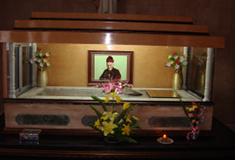 One of the long cherished dreams of the MSMHC was fulfilled on 3 December 1987 when the mortal remains of the Founder were transferred from Italy to Shillong. The wish of Bishop Ferrando himself, to be buried in India was also fulfilled on this day. A solemn requiem Mass was celebrated in the Cathedral of Shillong on 12 December. The mortal remains were then taken in procession to St. Margaret’s Convent Chapel (Shillong) and interred in a tomb artistically designed by Fr. L.B. Anthony SDB. On the visit of Fr. Tarcisius Resto, the then Vicar General of the Archdiocese of Shillong to Genova, Bishop Ferrando’s concluding message was: “I want my bones to be buried in Khasi-Jaintia hills.” The diocesan process for the canonization of the Servant of God, and founder of the MSMHC, Arcbishop Stephen Ferrando sdb, DD was initiated on 3 October 2003. The diocesan process was officially closed on 13 August 2006.
One of the long cherished dreams of the MSMHC was fulfilled on 3 December 1987 when the mortal remains of the Founder were transferred from Italy to Shillong. The wish of Bishop Ferrando himself, to be buried in India was also fulfilled on this day. A solemn requiem Mass was celebrated in the Cathedral of Shillong on 12 December. The mortal remains were then taken in procession to St. Margaret’s Convent Chapel (Shillong) and interred in a tomb artistically designed by Fr. L.B. Anthony SDB. On the visit of Fr. Tarcisius Resto, the then Vicar General of the Archdiocese of Shillong to Genova, Bishop Ferrando’s concluding message was: “I want my bones to be buried in Khasi-Jaintia hills.” The diocesan process for the canonization of the Servant of God, and founder of the MSMHC, Arcbishop Stephen Ferrando sdb, DD was initiated on 3 October 2003. The diocesan process was officially closed on 13 August 2006.
Important Events And Dates In His Life
The Great Fire (Destroying Angel) - 10 April, 1936 (Good Friday)
Foundations for the new Cathedral began to be dug – 8may 1936.
The foundation stone for the new Cathedral was blessed – 25 October, 1936
The return of Theology students to Mawlai - Shillong - 28April, 1938
The outbreak of World War II - 1 September 1939
Italy declared war on England & her allies - 10 June, 1940
Declared day of prayer for Peace to end the War - 24 November, 1940
Internment of the Missionaries - 11February 1942 (those for less than 16 years in India)
The First recruits from Kerala in South India reached Shillong - 1948
Volunteers from Diocesan Seminary Poonamallee, Madras arrived - 1955
Establishment of St. Paul’s Minor Seminary shilling - 1962
The founding of a new Indigenous Congregation (MSMHC) – 24 October, 1942
Fr. Uget- the Provincial gave Postulancy medal to 8 native girls -5 April 1942
First batch of 8 girls entered the Novitiate – 24 October 1942
Second batch of 7 girls admitted to the Novitiate – 8 December 1943
First profession of the First batch of sisters - 8 December 1944
India’s Independence - 15 August 1947
A devastating earthquake which rocked Northeast India – 15 August 1950 (7.30 p.m)
A new diocese is born proposed by Bishop Ferrando – 23 July 1951
Fr. Orestes Marengo ordained Bishop – 27 December 1951
Dedication of new Cathedral to Mary Help of Christians – 15 august 1954
Re establishment of the Salesian Novitiate at Sunnyside, Upper Shillong – 1956
The Chinese Invasion in the Indo China Border – northeast India affected – 1962
Withdrawal of Chinese troops from Indian Territory -21 November 1962.
Prayer
Almighty and ever living God, in your merciful love you desire the salvation of all people.
Down through the centuries you have called and appointed many men and women to be the heralds of the Good News, to the whole world.
In your great love for the people of North East India you consecrated your humble Servant Bishop Stephen Ferrando as our Shepherd.
Full of love and compassion for your people and with great zeal for your mission, he carried out your will in humility and simplicity and brought many people to your fold.
Just as he did, we seek your will in everything and beg of you Heavenly Father, if it is your will, to raise him to the ranks of the Saints, that his example may draw us to live always in accordance with your will.
We ask this in the name of Jesus your beloved Son. Amen.
With Ecclesiastical Approval Archbishop DOMINIC JALA SDB, D.D.
Please report any favour or miracle received through the intercession of the Servant of God Stephen Ferrando to:
The Postulation of the Cause for the Canonization
MSMHC Generalate Little Flower Convent Hatigaon, Guwahati - 781006, Assam - India.

